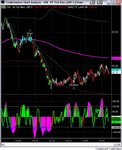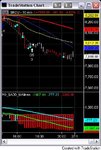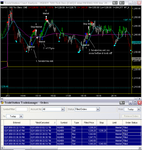leovirgo
Senior member
- Messages
- 3,161
- Likes
- 156
tricky spike
Got a nice short fom 89tick chart for DIA(INDU) at 82.40. It later developed into a swing trade and stop moved to breakeven + 4 ticks. Market DID crash but the spike touched the order and left with a mere +4ticks for 250+ move.
First chart is system entry and exit at lower TF 89 tick.
Second chart is INDU 10MC system trade entry and exit.
Looks very good on the chart but in reality only managed to scoop a staggering 4pts!!!
The question is ...
For a trade that goes 77% of target and hence must be trailed at breakeven stop, should it be re-entered once stopped out?
Well, market is market it will behave as it likes. I must stick to the discipline. I see no need to change anything as it was the spike. It is one harsh reality about the markets.
On stocks, had a nice run +100C on WFC. COF short is stopped out like DIA. hmmmm, run up profits vaporised although it could be a week's pay in one day.
On NQ, Vwap engine scalped some points. NQ was stronger than INDU and signal came later than INDU.
At the end of the day made some $$$ but could have been a much more profitable day. Discipline-wise a good day ....
Got a nice short fom 89tick chart for DIA(INDU) at 82.40. It later developed into a swing trade and stop moved to breakeven + 4 ticks. Market DID crash but the spike touched the order and left with a mere +4ticks for 250+ move.
First chart is system entry and exit at lower TF 89 tick.
Second chart is INDU 10MC system trade entry and exit.
Looks very good on the chart but in reality only managed to scoop a staggering 4pts!!!
The question is ...
For a trade that goes 77% of target and hence must be trailed at breakeven stop, should it be re-entered once stopped out?
Well, market is market it will behave as it likes. I must stick to the discipline. I see no need to change anything as it was the spike. It is one harsh reality about the markets.
On stocks, had a nice run +100C on WFC. COF short is stopped out like DIA. hmmmm, run up profits vaporised although it could be a week's pay in one day.
On NQ, Vwap engine scalped some points. NQ was stronger than INDU and signal came later than INDU.
At the end of the day made some $$$ but could have been a much more profitable day. Discipline-wise a good day ....







